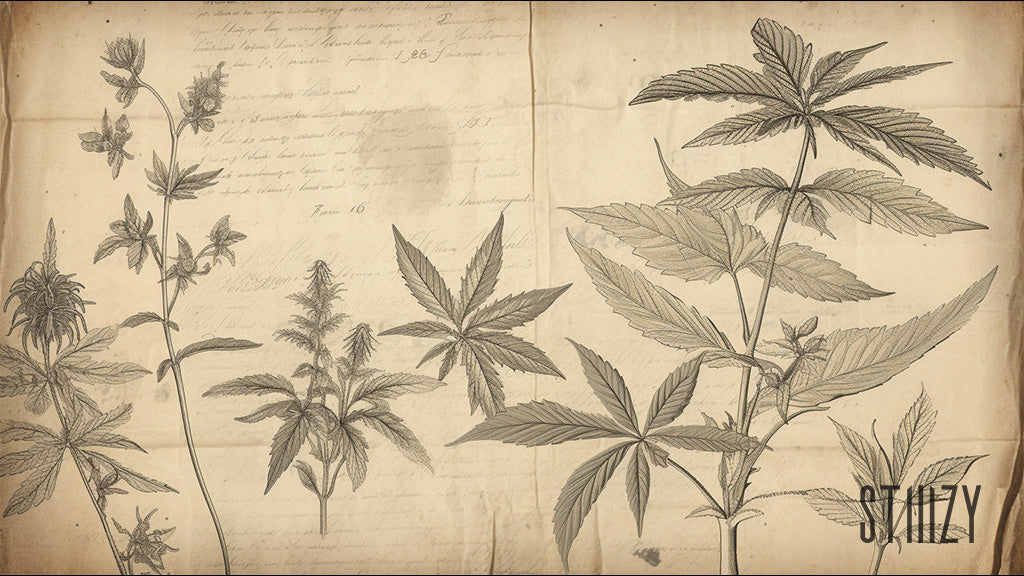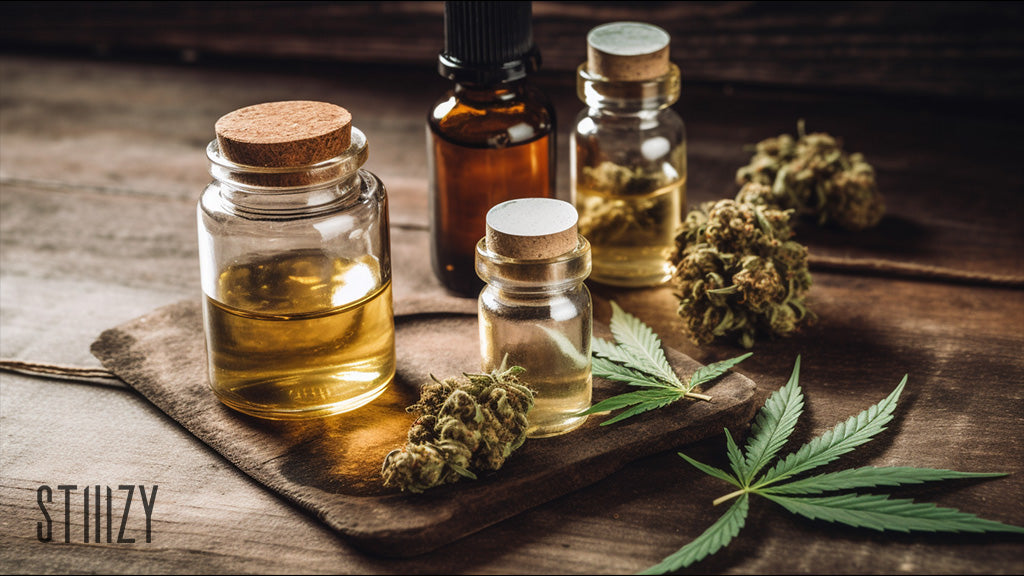History, Trends and the Future of Cannabis

From its historical roots as a medicinal remedy to its controversial past during the era of prohibition, cannabis has now emerged as a legitimate and thriving market.
As we look ahead to the future, it's essential for us to understand the current state of the industry, embrace its rich historical context, and explore the exciting opportunities and challenges that lie ahead.
A Brief Journey Through the History of Cannabis Market
Ancient Use of Medical Cannabis
The journey of cannabis use traces its roots to ancient times, dating back as far as 2800 BC in central Asia or Western China. One of the earliest documented accounts of its usage can be attributed to Emperor Shen Nung, known as the Father of Chinese Medicine, who recorded its medicinal properties in his pharmacopeia.
Throughout history, diverse civilizations, including the Greeks, Romans, Indian Hindus, and Assyrians, have recognized and harnessed the therapeutic potential of cannabis to treat an array of ailments, including depression, inflammation, and pain. The rich historical legacy of cannabis as a medicinal remedy underscores its enduring significance in the world of natural healing practices.
The Rise of the Marijuana Stigmatization
In the mid-1800s, cannabis finally reached Western medicine, gaining widespread recognition for its medicinal properties and therapeutic potential. Its versatility in treating various ailments and chronic diseases led to a demand for cannabis and its inclusion in numerous pharmaceutical products. However, the early 20th century witnessed a concerning turn of events with the rise of marijuana stigmatization.
In the aftermath of the Mexican revolution, recreational cannabis use became more prevalent, which fueled discriminatory sentiments against Mexican immigrants. Anti-drug propaganda emerged, strategically using cannabis as the scapegoat for perceived societal issues, particularly targeting the Mexican community. This stigmatization laid the foundation for a tumultuous era of cannabis prohibition that persisted for decades.
Reefer Madness
In the 1930s, The Great Depression cast a gloomy shadow over the nation. During this time, an American propaganda film called "Reefer Madness" emerged. This film perpetuated a highly sensationalized narrative that portrayed cannabis use as the root cause of deviant and violent behavior.
This cinematic exaggeration further contributed to the stigmatization of cannabis, instilling fear and mistrust in the hearts of the public. Regrettably, this climate of fear and misinformation culminated in the passage of the Marijuana Tax Act, merely a year after the film's release, which imposed exorbitant taxes on both medicinal and recreational cannabis use, tightening the noose on its legality and accessibility.
Counterculture Movement of the 1960s
In the 1960s, widespread tension and societal unrest gave rise to a powerful anti-establishment counter culture. Fueled by a desire for change and an eagerness to challenge the status quo, the youth of the nation sought alternative ways to express their discontent and explore new dimensions of consciousness.

Alongside the civil rights movement and opposition to the Vietnam War, the use of intense psychedelics, including LSD, and cannabis became emblematic of this transformative era. Many young people saw these substances as a means to break free from societal norms and explore the depths of their own minds, fostering a sense of unity, spirituality, and artistic expression.
The counterculture movement of the 1960s not only shaped the perception of cannabis but also sparked a revolution in attitudes towards personal freedom, social justice, and the quest for higher states of consciousness.
US Controlled Substance Act of 1970
After the counterculture of the hippies reignited the use of cannabis, the US unveiled the Controlled Substance Act that would list cannabis as a Schedule I drug having "no accepted medical use and a high potential for abuse," alongside drugs like Heroin and LSD. This act impeded both cannabis cultivation and research and restricted its use for decades.
Despite this, growing advocacy and evidence led to the gradual acceptance of medical cannabis in certain states. As public sentiment shifted, barriers began to break, offering hope for expanded research, potential medical breakthroughs, and broader legalization, shaping a more promising future for a legal cannabis industry with vast medicinal and economic potential.
The Shift Towards Cannabis Legalization and Acceptance
Over the past few years, there has been a significant shift towards cannabis legalization and acceptance in the United States. According to data retrieved by the National Conference of State Legislatures, as of April 24, 2023, a total of 38 states, along with three territories and the District of Columbia, have embraced the medical use of cannabis products, recognizing its potential therapeutic benefits for individuals with qualifying health conditions.

Additionally, as of June 1, 2023, 23 states, two territories, and the District of Columbia have taken progressive steps to regulate cannabis for adult non-medical use, acknowledging the demand for responsible recreational access to the plant.
This wave of acceptance is further evidenced in California, where a remarkable 64% majority of adult residents continue to support the state's cannabis legalization policy, as revealed by a recent survey conducted by the Public Policy Institute of California.
These figures illustrate a growing recognition of cannabis as a legitimate and valuable resource, both for medical and adult recreational purposes, signaling a significant transformation in the nation's perception and approach to cannabis.
Current State of the Cannabis Industry
As of the current state, the cannabis industry in the USA is experiencing a transformative and dynamic phase. The landscape has evolved significantly since the passage of state-level cannabis legalization initiatives, with many states allowing both medicinal and adult-use cannabis.
This widespread acceptance has fueled exponential market growth, creating a multibillion-dollar industry that continues to expand rapidly. As the number of legal cannabis states increases, so does the potential for job creation, economic stimulation, and tax revenue generation.
However, the industry still grapples with challenges, including varying regulations, banking restrictions, and a lingering federal classification as a Schedule I controlled substance. Nevertheless, increasing public support for cannabis and ongoing efforts to normalize its use are paving the way for a more promising and sustainable future for the cannabis industry in the United States.
Cannabis Legislation
Though California leads the way in cannabis' legalization efforts, the regulatory landscape remains intricate and challenging. State and local authorities continually work to fine-tune legislation to strike a balance between public safety and consumer access. Navigating the intricacies of California's cannabis laws can feel like navigating a maze.
Cannabis legislation extends beyond California's borders, as the push for cannabis reform and recreational marijuana has gained momentum nationwide. According to research conducted by Pew Research Center, 88% of US Americans believe that either medical or recreational cannabis should be legalized. With the increasing acceptance of cannabis for both medical and recreational use, numerous states have embarked on their own journeys to regulate and decriminalize the plant.
Yet the regulatory landscape remains a patchwork of varying laws and approaches, with some states still maintaining strict prohibition policies. The ongoing efforts to navigate the delicate balance between public safety, consumer access, and social equity have spurred discussions at the federal level as well. Advocates for federal cannabis reform argue for uniform regulations to ensure consistency and transparency in the industry.
However, the California cannabis market is experiencing the impact of slow federal reform, harsh state regulations, and a decrease in overall cannabis sales. According to the most recent statistics released by the California Department of Tax and Fee Administration, retailers recorded approximately $5.3 billion in taxable sales of recreational and medical marijuana last year, indicating an 8.6% decline from the previous year's total of roughly $5.8 billion.
This is believed to be due to a dramatic increase in wholesale pricing as a result of the elimination of the cultivation tax and the difficulty companies experience in obtaining licensing for retail spaces because of California's dual licensing system.
Tech Advancement
Nanotechnology
Advancements in cannabis technology have brought about innovative solutions that revolutionize the way we consume cannabis. STIIIZY has harnessed the power of nanotechnology to redefine the world of cannabis-infused edibles.

Through their cutting-edge approach, STIIIZY has developed a unique process that involves encapsulating cannabinoids in nanoscale particles. These tiny particles significantly enhance the bioavailability of cannabinoids, allowing for faster and more efficient absorption by the body.
As a result, consumers experience a more consistent and potent effect from their edibles. STIIIZY’s nanotech-infused edibles are rapidly gaining popularity, catering to those seeking a convenient and precise way to enjoy cannabis-infused treats.
Rosin Vape Pods
Most recently STIIIZY has taken the cannabis vaping experience to new heights with the release of their Solventless Vape Pod, known as The Live Rosin Pod. This groundbreaking product has captivated the attention of cannabis enthusiasts, offering a level of sophistication and purity rarely seen in the vaping industry.
STIIIZY’s Live Rosin Pods provide the ultimate entourage effect, combining a rich array of cannabinoids, terpenes, and other beneficial compounds present in the original cannabis plant. The revolutionary pod technology preserves the authenticity of the plant's essence, delivering a true full spectrum experience akin to dabbing without the need for a rig. For those with discerning tastes and a passion for the finest cannabis experiences, STIIIZY’s Live Rosin Pods have become a sought-after choice.
While vaping cartridges and pods have become increasingly popular, few competitors have ventured into the world of rosin vaping. STIIIZY stands out as one of the pioneers in this field, offering a unique and unparalleled experience to their consumers.
As the popularity of rosin continues to grow, STIIIZY’s Live Rosin Pods set a new standard in the vaping industry, captivating the attention of both seasoned enthusiasts and newcomers alike.
STIIIZY Hemp
STIIIZY has now ventured into the world of hemp, introducing a series of innovative products derived from this versatile plant. In particular, their focus on the lesser-known cannabinoid, delta-8 THC, sets them apart in the market. Delta-8 THC, a molecular cousin of the more common delta-9 THC found in cannabis, has gained considerable attention for its distinct properties and effects.
Unlike delta-9 THC, delta-8 is reported to offer a milder psychoactive experience, making it appealing to those seeking a more balanced and less intense high. STIIIZY’s innovative approach to utilizing hemp and highlighting the unique properties of delta-8 THC showcases their dedication to offering novel and refined experiences for consumers.
Embracing the world of hemp opens up a multitude of possibilities for STIIIZY, as this plant provides a rich source of cannabinoids, terpenes, and other beneficial compounds. By harnessing the potential of hemp-derived products, STIIIZY can now cater to a broader audience and diversify their offerings to meet varying preferences. Their commitment to exploring the potential of delta-8 THC further demonstrates their dedication to staying at the forefront of cannabinoid research and development.
Grass Hopper's foray into the world of hemp-derived products has the potential to reshape the industry, offering consumers a fresh and exciting array of options beyond traditional cannabis. Through their innovative approach and emphasis on the unique properties of delta-8 THC, Grass Hopper is poised to leave a lasting impact on both the cannabis and hemp markets, providing enthusiasts with a whole new spectrum of experiences to explore. As they continue to pioneer the possibilities of hemp, the future holds great promise for Grass Hopper Cannabis and its growing community of consumers.
Trends in Cannabis Consumption
Trends in cannabis consumption have experienced notable shifts in recent years, encompassing a wide array of innovative products catering to evolving consumer preferences. While alternative consumption methods like edibles, concentrates, and vapes have gained substantial popularity, one steadfast trend that continues to dominate cannabis clubs is the enduring appeal of cannabis flower.

Despite the influx of diverse products, traditional cannabis flower remains the most popular item in these establishments. Renowned for its versatility and familiar smoking experience, cannabis flower remains a staple choice for many enthusiasts, providing a vast range of strains and effects to suit individual tastes.
We foresee a continuation to this trend. As the industry continues to embrace innovation, cannabis clubs persistently celebrate the timeless allure of this natural and iconic form of cannabis consumption.
Health and Wellness
Beyond the well-known THC and CBD, there is a growing interest in exploring the potential health benefits of other cannabinoids found in cannabis, such as CBC, CBG, THCV, and CBN, to name just a few. These lesser-known cannabinoids are captivating researchers with their unique properties and potential therapeutic effects.

Additionally, terpenes, the aromatic compounds responsible for the distinctive scents of different cannabis strains, are also being studied extensively for their effects. These aromatic molecules are believed to play a crucial role in the entourage effect, enhancing the overall therapeutic potential of cannabis products.
As a result, we are witnessing a surge in the inclusion of terpenes in a wide range of health products, such as oils, tinctures, and topicals, further solidifying cannabis's role in the realm of health and wellness. The ongoing exploration of these diverse compounds presents an exciting frontier, shaping a promising future for cannabis in the domain of holistic health.
Conclusion
Although the journey has been rocky, the future of cannabis appears to be incredibly promising, with a multitude of exciting developments on the horizon. The cannabis industry has come a long way, moving from a shadowy past of prohibition and stigmatization to a future characterized by acceptance, exploration, and innovation.
As more states embrace cannabis legalization, both for medical and recreational purposes, the industry continues to experience exponential growth and economic opportunities. Advancements in cannabis technology, such as our nanotech-infused edibles, vaping system, and Rosin Pods, demonstrate the industry's commitment to enhancing user experiences and diversifying cannabis offerings, catering to a more diverse audience.
As we move forward, it is crucial to recognize the importance of responsible consumption, education, and advocacy. The ongoing research into cannabis health and wellness, alongside the development of comprehensive regulatory frameworks, will play a vital role in shaping the industry's growth and ensuring public safety.
With public support for cannabis reform steadily increasing, there is hope for continued progress in federal cannabis legislation and state regulations, further promoting research opportunities, business growth, and unlocking the plant's full potential.
The content provided on this blog is for informational purposes only and is not intended as professional medical advice, diagnosis, or treatment. Please consult with your healthcare provider and local laws before purchasing or consuming cannabis.

